

Table of contents
- Characteristics
- location claims
- soil condition
- planting
- Planting time and planting depth
- planting guide
- care instructions
- watering and fertilizing
- Cut
- hibernate
- multiply
- sowing
- spring onions
- diseases and pests
The flowers of the checkerboard flower appear in an elegant white, pink, red or intense purple. In Germany, this pretty spring bloomer is one of the protected plants. One more reason to plant it.
Characteristics
- Plant Family: Liliaceae, Liliaceae
- Botanical name: Fritillaria meleagris
- German names: checkered flower, lapwing, ordinary checkered flower
- Growth: perennial, upright, loose, sprawling, overhanging
- Growth height: 25-35 cm
- Foliage: green, linear, acuminate, entire
- Flowers: bell-shaped, white, pink, red, purple, checkerboard pattern
- Flowering time: April to May
- Lime tolerance: sensitive to lime
- Toxicity: toxic
location claims
In accordance with its natural habitat, it prefers sunny to semi-shady, rather cool and humid locations. Even on fresh to swampy soil, e.g. B. in a meadow near a body of water, she can stand without any problems. However, the meadow should not be mowed before the seeds have ripened at the end of June.
Anything else would be very detrimental to the preservation of the stock. The same applies to the fertilization of wet meadows. It would cause the checkered flower to be quickly overgrown by other plants. If this plant feels comfortable in one location, it can form dense stands.
soil condition
The checkered flower feels most comfortable on fresh, moist, well-drained and nutrient-rich soil. They should be slightly acidic to neutral. Conditions are ideal on wet meadows and near ponds. If the plant is to stand in a bed or planter, the soil must be kept constantly moist. Clay soils should be mixed with coarse sand. Commercial potting soil for flowering plants is suitable for keeping in the bucket.
Tip:
Even if the checkered flower loves moist surfaces, it does not tolerate waterlogging.
planting
You don't always have to buy ready-made plants or wait until you get a checkerboard flower as a gift. We show how planting onions works and what you should pay attention to.
Planting time and planting depth
Ideally, the bulbs should be planted immediately after purchase, as they dry out relatively quickly. The best time for planting is between August/September and November, but preferably in September because the bulbs take root very slowly. Planting distances of 15-20 cm are recommended so that the bulbs have enough space to form daughter bulbs.
planting guide
Before planting, it is advisable to loosen the soil to a spade-deep level and remove weeds, stones and root remains. To help the plants grow, you can improve the soil with compost or horn shavings. Then you create the planting holes.
- Planting holes twice as deep as the bulb is large
- Between eight and ten centimeters
- Put a thin layer of sand on the bottom of the planting holes
- Sand protects onions from rotting
- Then add onions
- Fill planting holes with soil, press soil down
- Thoroughly water the planting site
- Never allow the soil to dry out
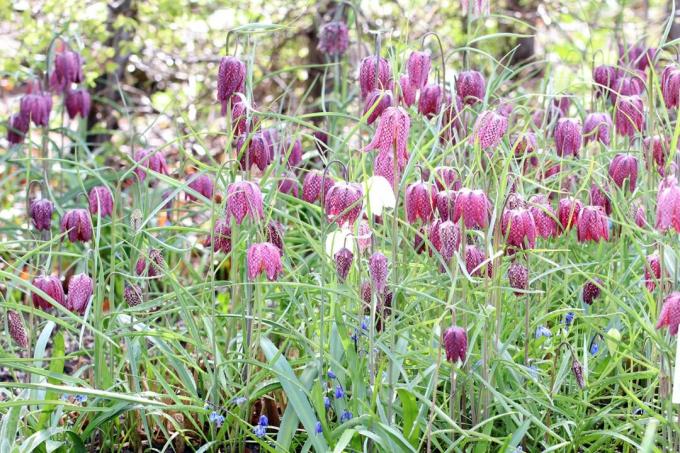
When planting in a tub, make sure there are drainage holes and good drainage. Since these plants completely withdraw after flowering, it is advisable to mark the planting site. This way you know where the bulbs are next spring and cannot accidentally dig them up.
Caution:
checkered flowers (Fritillaria meleagris) are poisonous in all parts of the plant, especially the bulb. It is better not to plant them in areas where there are small children.
care instructions
In any case, it is worth leaving a spot free for Fritillaria meleagris in your home garden, especially since it has now become rare in the wild. It has proven to be extremely easy to care for, robust and undemanding.
watering and fertilizing
- Keep soil evenly moist all year round
- Even after the leaves have been drawn in
- Water little or not at all in generally damp locations
- Water regularly and more frequently in normal garden soil
- Provide specimens in the bucket most often with water
- Substrate in the bucket dries out quickly
As far as the nutrient requirements of checkered flowers are concerned, it is usually sufficient if you treat the common checkered flower to a dose of compost in the spring. Container plants should be supplied with a liquid fertilizer for flowering plants every two weeks during flowering.
Cut
Pruning measures as with most other plants are not necessary here, on the contrary. The stems and leaves should remain until they are completely wilted. As long as there are still green parts of the plant, the onion draws out valuable nutrients and stores them. In this way, it creates important energy reserves for the winter and for budding next year.
hibernate
The checkered flower grows perennial and has a good winter hardiness. It can handle even very harsh winters. It tolerates temperatures down to minus thirty degrees. As a result, it can hibernate outdoors without any shelter. Drought, on the other hand, is also dangerous in winter. If there is no protective snow cover, there is a risk of frost if there is heavy frost at the same time.
The bulbs cannot absorb moisture from the frozen soil and must therefore be watered on frost-free days. The irrigation water should be cold, otherwise the onions could sprout prematurely. Somewhat more endangered are specimens in tubs, they cannot do without winter protection and watering.
Tip:
After a successful hibernation, it is the best time to repot potted plants. This should generally be done every two to three years.
multiply
If you already have a checkerboard flower, you can also draw other plants from it. We show what options there are for propagating checkerboard flowers and how to implement them.
sowing
Basically, this plant will self-seed if the seeds fall on fertile soil. Of course, you can also sow them by hand. multiply. Seeds for sowing can be purchased or harvested from existing plants.
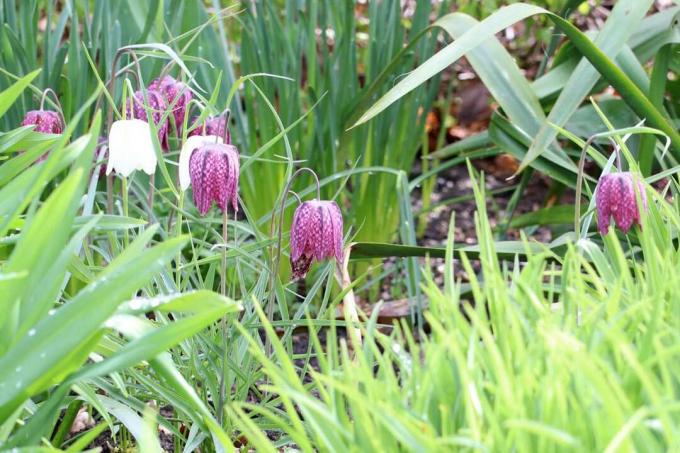
As soon as the three-chambered seed pods on the plant have matured, around between May and June, they are cut off. The seeds, which belong to the cold germs, must then be subjected to a cold treatment.
Stratify
- Scoop out the seeds from the capsules
- Place in a freezer bag with some damp sand
- Seal bag, not too tight
- Store in a warm place for about two weeks
- At temperatures between 18 and 20 degrees
- Then seal the bag tightly and place in the fridge for four to six weeks
- Temperatures now between zero and five degrees
- Don't let the sand dry out in the bag
- After the end of the cold treatment, sow seeds
sowing
- Sow directly or in seed trays
- Thoroughly loosen the soil at the sowing site
- Soil should be finely crumbly
- Mix seeds with commercially available potting soil
- Spread over a wide area at 18-20 degrees
- Cover thinly with soil
- Then moisten the soil
- Cover seed trays with translucent film
- Remove cover daily for ventilation
- Put in a bright and warm place
- Avoid direct sunlight
- floor or Keep substrate evenly moist
As soon as the seedlings are about four inches tall, they can be separated into small pots or directly in the bed. If the seeds are not sown in spring but in autumn, the plants should overwinter frost-free.
Tip:
Due to the stratification, sowing is quite complex and time-consuming. Usually only about 50 percent of the seeds sprout.
spring onions
Another and relatively simple method of propagation is via onion bulbs. They form on the side of the mother bulb. After the plants have moved in, the bulbs are dug up and the brood bulbs removed, if possible without damaging them or the mother bulb. The mother bulb is immediately replanted. Since the small spring onions dry out quite quickly, they should also be planted directly on the spot at the appropriate depth. Finally water well again.
onion scales
Like all lilies, the bulb of the checkered lily has a scale-like structure. This enables propagation via onion scales. The best time for this form of propagation is also when the plants have moved in.
- Carefully dig up the onion
- Depending on the size, peel off four to six outer scales
- Leave a small piece of onion base on each scale
- Sprinkle injuries to the mother onion with charcoal powder
- Put the mother onion straight back into the ground
- Then fill small pots with potting soil
- Stick the onion scales about halfway into the substrate
- Put a translucent plastic bag over the pots
- Place in a partially shaded place
- Keep the substrate slightly moist and aerate regularly
- Optimum germination temperatures around 20 degrees
- First flowers after three to five years
As soon as the onion scales have formed roots and, at best, small onions, they can be transplanted. Or you just cover them with soil so that only a small tip sticks out. The whole thing is then placed in a cool place about five degrees and in the following spring outdoors. By late summer, the bulbs should be strong enough to plant in their final location in the garden.
diseases and pests
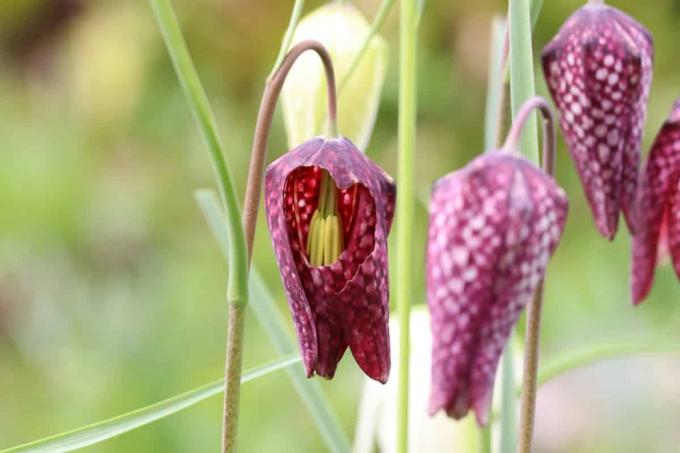
onion rot
Onion rot is usually caused by too much moisture. Even if the checkerboard flower needs a lot of water, it does not like waterlogging. The plants quickly lose their strength and turn yellow. There is usually a putrid smell. The checkerboard flowers can then no longer be saved.
snails
A common problem is snails, and there are different types. They are often attracted to the humid environment. To protect the plants, they should be checked regularly for signs of damage and any snails should be consistently removed.
lily chicken
Sometimes the lily beetle feasts on the leaves of the checkerboard flower, where it can cause massive damage. They are very easy to spot by their bright red shield. To combat this, you should read off the adult beetles regularly and rinse the plants thoroughly to catch their larvae as well. Spreading rock flour or dry coffee grounds can also be helpful.
voles
Voles can cause particularly serious damage. By the time they are discovered, it is usually too late. Combat is quite difficult. It should be most promising from autumn to spring. At this time they will not find as much in the garden and will accept bait all the better. Probably the only effective remedy are vole traps, which are available in abundance in stores. As a rule, however, you need more than just one trap in order to be able to equip every active corridor with it.
 garden editorial
garden editorial I write about everything that interests me in my garden.
Learn more about flower bulbs
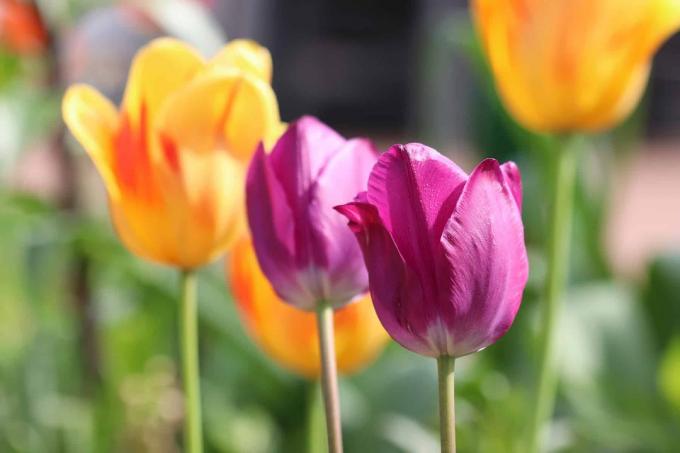
Tulips do not bloom and only put out leaves: what to do?
Tulips are among the most popular spring bloomers. They are therefore extremely common in domestic gardens. However, various causes can lead to the onion plants only developing leaves and no flowers. You can find out what to do in this case here.

Madonna lily, Lilium candidum: 9 care tips
Due to its growth height of more than one meter and the imposing white funnel-shaped flowers, the Madonna lily is one of the most impressive native bulbous plants. What to look out for when caring for this impressive flower is summarized in 9 clear care tips.

Daylilies, Hemerocallis: care from A – Z
Daylilies (Hemerocallis) are among the loveliest and most rewarding flowering perennials. Even if each individual blossom lasts only one day, countless new blossoms form again and again and decorate the garden for weeks. In addition, they are available in almost every color imaginable.

Freesia, Freesia: care tips from A - Z
Freesias are popular summer plants because they are colorful and have a pleasant, delicate scent. The irises, originally from Africa, are not difficult to care for, but do not tolerate frost. You can easily propagate the freesias yourself using the bulbs.

Milk Star, Ornithogalum: care from A to Z
The Orange Milk Star (Ornithogalum dubium) is a popular ornamental plant from the Cape Province. Because of its decorative flowers, it is often used as a cut flower in flower arrangements. The ornamental plants are undemanding, but should be cared for with caution due to their toxicity.
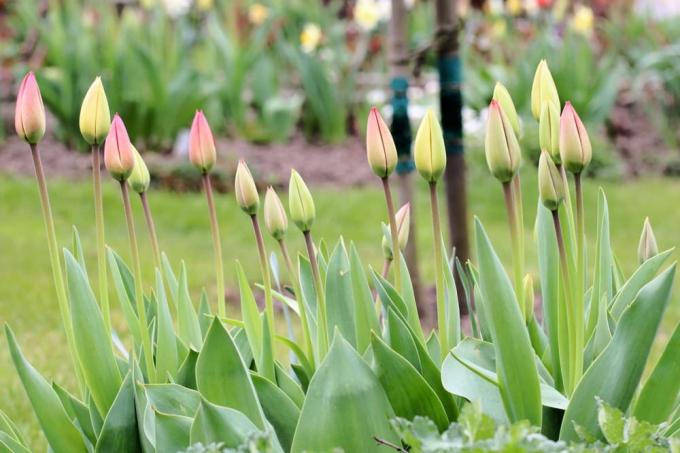
The perfect time to plant tulips is in the fall
Planting the tulip bulbs is an exciting time before winter. Tulips need a cold stimulus to sprout in the coming season and be able to present their flowers. If the right planting time is observed, nothing stands in the way of flowering.



